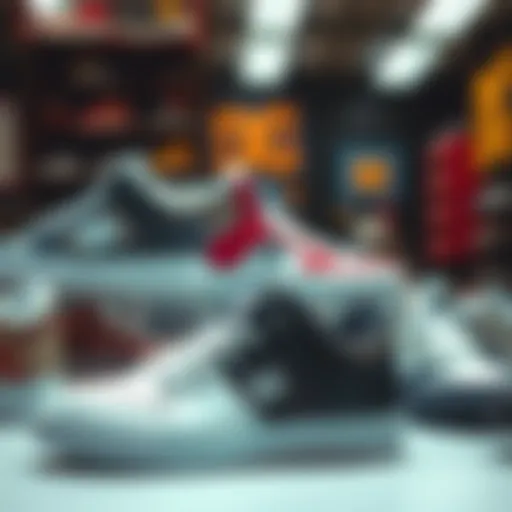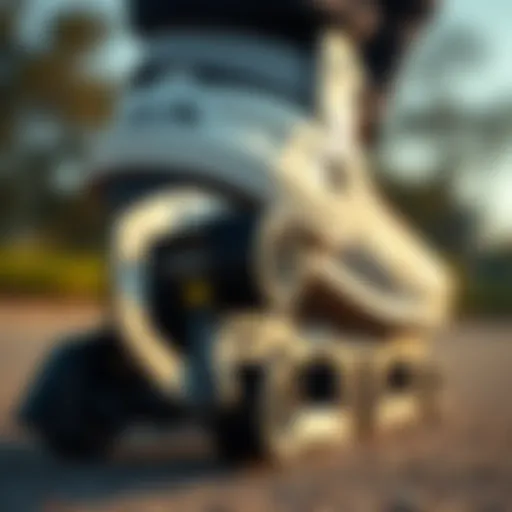Beginner Cruiser Skateboard: Your Essential Guide
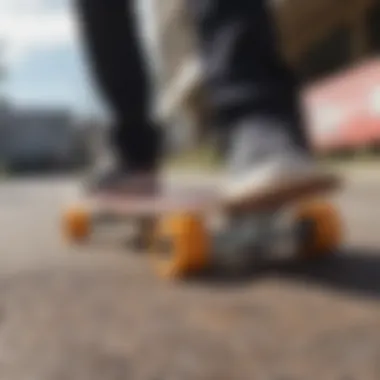

Intro
Skateboarding is more than just a sport; it’s a culture, a way of life, and for many, it’s a path to personal expression. For beginners, choosing the right skateboard can make or break the experience. Among the various types, cruiser skateboards stand out as an excellent entry point for new riders. Their design caters to easy maneuverability and stability, which are key for someone learning the ropes.
This guide offers a deep look into beginner cruiser skateboards, focusing on the essentials that aspiring riders need to know. From understanding the specific features of these boards to diving into vital techniques and safety tips, every detail is crucial for those looking to carve their path on four wheels.
Skills Development
Learning to skateboard involves both physical skills and mental strategies. Mastering the basics can boost confidence and lay the groundwork for further development.
Basic Tricks and Techniques
For new riders, starting with the fundamental tricks can feel like trying to build a house without a solid foundation. Here’s a straightforward breakdown:
- Pushing Off: This is as basic as it gets but essential. Place your back foot on the tail and use your front foot to push off the ground.
- Turning: Use your body weight to lean; the board will follow your direction. Start with gentle turns before navigating sharp corners.
- Stopping: Learning to stop safely is crucial. The foot brake involves placing your back foot on the tail and pressing down.
As you grow more comfortable, integrating turns and stops into your routine will come naturally.
Advanced Maneuvers and Tips
Once you’ve mastered the basics, challenging yourself with more advanced moves can elevate your skills:
- Carving: This involves smooth side-to-side movements, which gives you an incredible sense of freedom and speed.
- Tail Spins: Starting with small spins can gradually build your ability to handle full rotations. Make sure you are confident with your balance first.
- Ollies: This is a fundamental trick in skateboarding, allowing you to lift the board off the ground. It requires practice but pays off in versatility.
Pro Tip: Always practice in a safe environment. Empty parking lots or smooth sidewalks will reduce the risk of injury while you master these techniques.
"Perfect your basics, and the rest will follow; a strong foundation fosters great riders."
Gear and Equipment Reviews
Finding the right gear can enhance your skating experience significantly. With a range of products available, it’s important to choose wisely.
Skateboards and Accessories
When picking your first cruiser skateboard, consider:
- Size and Shape: Cruiser boards are generally wider and have softer wheels, making them easier to ride. Look for boards around 28 to 32 inches long.
- Materials: Most are made of maple or bamboo. Bamboo tends to offer a lighter and more flexible ride.
- Wheels: Softer wheels (78A - 87A durometer) are ideal for cruising over rough surfaces while providing a smoother ride.
Some recommended brands include Penny Skateboards and Landyachtz, known for quality and favorable designs for beginners.
Safety Gear and Recommendations
Safety cannot be stressed enough. Here’s a quick checklist of must-have safety gear:
- Helmet: Protects your head. Look for a CPSC certified helmet.
- Wrist Guards: Great for preventing wrist injuries during falls.
- Knee and Elbow Pads: These help cushion impacts and keep your joints safe.
Joining a community, whether on forums like reddit.com or local skating groups on facebook.com, can also provide valuable insights and encouragement.
In closing, starting your skateboarding journey with a beginner cruiser board not only makes learning the ropes easier but also infuses fun into the process. Equip yourself with the right gear, master the skills, and enjoy the ride!
Understanding Cruiser Skateboards
When it comes to the world of skateboarding, grasping the nuances of cruiser skateboards is essential for novice riders. Cruiser skateboards stand out not just for their aesthetics; they offer dynamic features that cater to those who are new to riding. Understanding these boards allows beginners to make informed choices, enhancing their skating experience.
A solid comprehension of cruiser skateboards encompasses their definitions, unique characteristics, and the pivotal role they play in easing new riders into the sport. With a balanced design and substantial ease of use, they are tailored for individuals looking to navigate the streets or shores.
Definition of Cruiser Skateboards
Cruiser skateboards are a specific category of skateboards designed primarily for smooth rides and effortless navigation. These boards are characterized by their wider decks and softer wheels, making them particularly comfortable for cruising around town or on bike paths. The broader wheelbase contributes to improved balance, which is crucial for beginners still finding their footing on a skateboard.
Key Characteristics
The allure of cruiser skateboards lies in their distinctive qualities, each of which contributes to their overall functionality and appeal for newcomers.
Deck Shape
The deck shape of a cruiser skateboard plays a pivotal role in determining its usability. Generally, the decks are wider and often feature a concave design. This shape is great for providing ample foot space and offers a more stable platform for balance. Wide decks can support different foot placements, which is beneficial for riders still mastering the basics. The round, gentle curves of a cruiser deck also lend themselves to a more relaxed ride, encouraging leisurely sessions over complicated tricks.
Wheel Size and Material
Moving onto the wheel size and material, these components significantly affect the ride. Cruisers typically come equipped with larger wheels, often around 55mm to 60mm in diameter. This larger size allows the rider to travel over bumps and cracks without losing momentum. Furthermore, wheels made from softer urethane materials provide better grip, making it a top pick for beginners cruising over varied surfaces. While the benefit of softer wheels is evident for absorbing shock, they may wear down faster on rugged terrain compared to harder wheels, which could be a consideration for long-term use.
Trucks and Stability
Lastly, the trucks and stability aspect of cruiser skateboards cannot be overlooked. For a cruiser skateboard, the trucks are often made to be wider in relation to the deck, providing immense stability and reducing the chance of wobbling at higher speeds. This gives beginner riders the confidence they need to venture out on their boards. Wide trucks, combined with a lower height, create a stable center of gravity which is helpful when learning to shift body weight responsibly. On the flip side, too much focus on stability might reduce the ease of making sharp turns or performing tricks, issues that can be important as riders progress.
"Understanding the basic components of cruiser skateboards can significantly enhance a new rider's experience as they embark on their skating journey."
In summary, the unique characteristics of cruiser skateboards make them a favorite among beginners. Knowing the ins and outs of deck shapes, wheel sizes, and truck stability enables riders to choose a board tailored to their needs, setting the stage for smoother sailing in the skating realm.
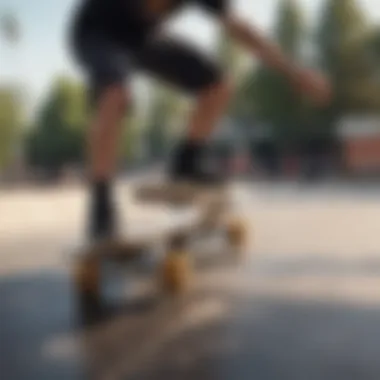

Benefits of Using a Cruiser for Beginners
When stepping into the world of skateboarding, a cruiser board is like a friendly guide showing you the ropes. These boards are tailored for novices, making them an excellent choice for anyone just starting out. In this section, we’ll dive into the specific benefits that make cruiser skateboards a popular pick for beginners, helping to foster a more enjoyable and secure riding experience.
Enhanced Maneuverability
One of the standout features of cruiser skateboards is their exceptional maneuverability. With a compact design, cruisers are crafted to weave through crowded streets and tight spaces effortlessly. This aspect is particularly beneficial for beginners. Within the urban environment, the ability to steer away from obstacles, like pedestrians or parked cars, becomes second nature when using a cruiser. The shorter wheelbase allows for sharper turns, which can feel exhilarating and boosts confidence.
Moreover, the smaller deck and softer wheels provide a smoother ride over imperfections in the road. New riders won’t find themselves rattled by bumps or cracks, allowing them to focus on developing their skills without the anxiety of loss of balance or control. Thus, the maneuverability of a cruiser makes the learning process much more enjoyable and less daunting.
Comfort and Stability
Comfort is another key element that draws beginners towards cruiser skateboards. These boards are typically wider and have a longer deck than standard skateboards, which aids in stability. When you're just learning, having a stable platform to stand on is crucial. It helps keep balance easier, allowing novices to focus on learning the basic techniques instead of constantly worrying about tipping over.
Additionally, most cruisers feature larger, softer wheels that absorb shock and make the ride more pleasant. This eases the strain on the feet and ankles, which can be especially comforting for someone who is just starting to get accustomed to standing on a board. When the ride is comfy, it promotes longer sessions without fatigue, helping beginners to build their skills at a comfortable pace.
Ease of Learning Basic Tricks
Though beginners might not start by attempting tricks, ease of progression is vital in keeping the interest alive. The shape and design of cruiser skateboards help with this transition. Unlike traditional boards geared towards tricks, cruisers allow novice skaters to interact with the board fully and at their own speed.
For example, simple maneuvers like popping the tail for a small ollie or sliding into a gentle turn come with less fear and more fun. Riders can gradually develop their balance and agility, making it easier to take on more advanced skills as they gain confidence. Many find that learning tricks on a cruiser can transition seamlessly to a regular skateboard once they are ready.
In essence, a cruiser skateboard serves as a reliable partner in the early journey of skateboarding, offering benefits that are comforting and enjoyable. Choosing a cruiser isn’t just about picking a board; it’s about selecting a tool that fosters confidence, comfort, and adaptability. This makes the learning experience much richer and less intimidating.
Choosing the Right Cruiser Skateboard
Selecting the right cruiser skateboard is crucial, especially if you are a beginner. The proper skateboard can enhance your riding experience, make learning easier, and keep you safe. If you pick one that doesn’t match your style or needs, it can lead to frustration and a lack of enjoyment. This section hides valuable insights into identifying your riding style, considering materials that fit your preferences, and understanding how to budget effectively. By following the advice here, you not only embark on a smooth ride but also build a solid foundation for future skateboarding endeavors.
Identifying Your Riding Style
Your riding style significantly influences the type of cruiser that best suits you. Knowing whether you'll be commuting, riding leisurely, or trying out tricks can help narrow down your options.
Urban Commuting
Urban commuting is a common way to use cruisers. It focuses on getting from point A to B in city conditions. The key characteristic here is agility. Urban cruisers often come equipped with smaller wheels, which improve maneuverability in tight spaces, allowing riders to navigate around pedestrians and obstacles. These types generally sport lightweight decks making them easy to carry when not riding. The main advantage of urban riding is practicality; you can weave through traffic and get to destinations quickly. However, there’s a downside — they might not be as comfortable for longer rides due to wheel hardness.
Leisurely Riding
Leisurely riding embraces a more relaxed approach. This lovely style is all about enjoying the breeze as you cruise down pathways or along the waterfront. One standout trait is comfort; cruisers designed for this purpose usually feature wider decks for stability and larger, softer wheels that cushion the bumps on uneven terrain. If you're looking for a laid-back experience where you can enjoy the scenery, leisurely riding is a fantastic fit. The downside? They’re not ideal for sharp turns or tricks, so if you aspire to perform stunts, this option might limit you a bit.
Trick Performance
If tricks and performance are what you seek, then you may want to consider a board that emphasizes pop and control. Positioned between a cruiser and a traditional skateboard, a trick-performance cruiser allows for basic maneuvers and tricks like ollies. It typically features a shorter, sturdier design that caters to skilled riders who want to execute flips or grabs. Trick performance boards can be loads of fun, but they might lack some of the comfort features that cruisers provide, making long rides a bit of a challenge.
Material Considerations
The materials used in a skateboard play a significant role in how it performs and your riding experience. Wood and plastic are common options, each offering different advantages.
Wood vs. Plastic
When choosing between wood and plastic, wood remains the top choice for many skate enthusiasts because of its flexibility and durability. A wooden skateboard often provides a better feel when riding, helping with balance and control. On the other hand, plastic decks can be lightweight and weather-resistant, making them ideal for wet environments or younger riders. While wood offers more stability, plastic boards can bend more, affecting performance. Ultimately, the choice between these two materials will depend on your riding style and needs—wood for serious riders, plastic for casual use.
Durability Factors
Durability factors are essential to consider when picking a cruiser. A skateboard's lifespan can depend on several elements, including the material, construction method, and how you handle it. Typically, wood boards offer a longer lifespan when properly maintained, especially if they feature layered construction. Plastic boards, while often fun and colorful, can show signs of wear more quickly and may not withstand rough landings or excessive wear and tear as well. Choosing a reasonably durable board is paramount as it aligns with your riding habits and expectations for the long run.
Budgeting for Your First Skateboard
Budgeting is a necessary part of the process when purchasing your first skateboard. A clear understanding of price ranges and value can help you avoid overspending or acquiring a board that won’t meet your needs.
Price Ranges
Price ranges vary widely depending on the board's brand, materials, and design. Entry-level cruisers often cost between $50 and $150, focusing on quality with affordability. They usually strike a balance between performance and durability, making them perfect for value-conscious beginners. But there are high-end models that can stretch into the $200 range, offering superior materials and advanced features. Understanding where you stand in this range helps set realistic expectations.
Value Equation
Lastly, the value equation plays into your purchasing decision. It considers how much you’re willing to pay and what you receive in return. A good skateboard creates a balance of price, performance, and durability. Investing more upfront might save you money in the long run by reducing the need for replacements or repairs. A budget cruiser might be suitable for someone just starting; however, if you find yourself using it frequently, consider investing in a board that offers better durability and features, thus enhancing your overall skating experience.
Fundamental Techniques for Beginners
In skateboarding, especially for those just starting out, mastering fundamental techniques is essential. These skills lay the groundwork for becoming a proficient rider. Without a solid grasp of basic movements, enthusiasts risk frustration and injury. Moreover, understanding fundamental techniques improves overall confidence on the board, allowing newcomers to fully enjoy their cruising experience.
Basic Stance and Balance
Finding your balance on the board is not just a matter of standing still; it's the core of riding. Your stance affects everything from speed to your ability to perform tricks later on. Most beginners generally adopt one of two positions: the goofy foot (right foot back) or regular (left foot back).
To determine your stance, you might try this little trick: stand on a smooth surface, have someone gently push you from behind and see which foot comes forward naturally to stabilize yourself.
Once you’ve figured that out, it's all about stance width and body position. A wider stance can provide better stability, while a narrower one often allows for greater maneuverability.
Here are some tips to improve your stance:


- Feet Placement: Make sure your feet are shoulder-width apart, making it easier to distribute weight.
- Knees Bent: Keeping them slightly bent helps absorb shocks from uneven terrain.
- Shoulders Over Hips: This alignment helps in maintaining balance.
Using these adjustments, you'll build a solid foundation to ride safely and confidently.
Pushing and Stopping
Once you're comfortable with your stance, the next fundamental skill is pushing off and stopping. This isn't just an art; it's a vital skill that governs your control over speed.
Pushing off:
To start moving, place your back foot on the tail and your front foot just behind the front trucks. Here’s a simple breakdown:
- Find your rhythm: Push off with your back foot while keeping your weight balanced between your feet.
- Push away: Use thrusting motions rather than a shuffling technique.
- Maintain Momentum: Don't overdo the push; short, controlled pushes will keep you moving efficiently.
Stopping:
As you get comfortable pushing off, knowing how to stop is equally important. There are a few methods:
- Foot Drag: Drag your back foot on the ground to reduce speed.
- Heel Brake: If your board has a tail, you can apply pressure on it to help stop.
- Carve and Slow Down: Gently turn side to side to dissipate speed.
Remember, learning to stop is as vital as knowing how to go. These maneuvers give you greater control, ensuring your safety on the board.
Turning and Carving
Turning and carving transform a basic ride into a more fluid experience. Mastering these techniques can greatly enhance your cruising enjoyment. Turning is fundamental for navigating around obstacles; carving allows you to hold speed while changing direction.
Turning:
Turning can be achieved by leaning in the desired direction while applying pressure to your toes or heels.
- Front-foot Lean: Press down on your front foot to initiate a turn.
- Back-foot Control: Use your back foot to stabilize and control speed during the turn.
Carving:
Carving is a smoother, more fluid version of turning. It’s often done by shifting your weight from toe to heel, allowing for graceful arcs.
- Weight Shift: Lean into the direction of the turn.
- Smooth Movements: Use long and fluid motions to maintain momentum.
Through practicing turning and carving, beginners gradually develop a feeling for their board. It’s like dancing with the pavement; every tilt, every lean invites new possibilities.
"Skateboarding is about rhythm and flow. The more you practice these techniques, the more fluidly you'll move."
Overall, understanding and practicing these fundamental techniques are crucial steps in the journey of becoming a skilled cruiser skateboarder. As you become more comfortable with your stance, learn how to push and stop effectively, and practice turning and carving, every ride will feel a little more natural and enjoyable.
Safety Considerations for New Riders
Safety should be the cornerstone of any skateboarder's experience, especially for beginners. When you're just stepping onto a board, understanding safety measures can mean the different between a good ride and a painful one. This section digs into the importance of protective gear, safe riding spots, and the necessity of being aware of surroundings, which all work together to help newcomers enjoy their skateboarding journey without unnecessary risks.
Protective Gear Essentials
Helmets
Wearing a helmet is perhaps the most critical aspect of skateboarding safety. Helmets protect your head from potential injuries, which is particularly vital for newbies who might still be finding their balance. The good helmets come with a hard shell that can absorb impact, adding a layer of security. A well-fitted helmet, one that stays snug during movement, is a beneficial choice for safety because it ensures maximum protection when falls happen. A unique feature of modern helmets is the ventilation system designed to keep riders cool during those long rides. While some think helmets can be uncomfortable or cumbersome, many models are lightweight and offer a comfortable fit that doesn’t hinder the riding experience.
Kneepads and Elbow Pads
Kneepads and elbow pads are essentials for protecting joints that are prone to injury. These pads cushion impacts and can significantly reduce the discomfort from falls. A key characteristic of these pads is their shock-absorbing foam, which provides extra defense during spills. They are particularly popular among beginners as they offer peace of mind when venturing out. The unique feature here is the adjustable straps, ensuring a snug fit without cutting off circulation. The downside? They can feel hot and restrictive during warmer weather, yet the benefits can far outweigh any temporary discomfort, particularly while learning.
Proper Footwear
Selecting the right shoes is crucial. Footwear should provide adequate grip and support as beginners need stability when pushing or turning. Good skate shoes have a flat sole with a decent tread pattern, which enhances board feel. This means that you can feel the board beneath your feet, providing a connection that improves control. A downside to some skate shoes, however, can be they wear out quicker than regular sneakers due to the friction with the board. But, investing in a quality pair is worth it for the balance and support they provide while riding.
Choosing Safe Riding Areas
Quiet Streets
Finding a quiet street can be a game-changer for new riders. These streets usually have less traffic, making it safer to practice basic skills without the worry of unexpected cars. A key characteristic of quiet streets is their low traffic volume, which allows for a relaxed learning environment. Additionally, if you encounter a slight downhill, practicing kicks or turns becomes much easier. However, keep in mind that living right by a main road means you might need to travel a tad further, but the peace of mind is invaluable.
Parks and Skate Areas
Parks and designated skate areas offer a setup designed for both fun and safety. They often have smooth surfaces and ramps that encourage skill development. One of the benefits of these locations is that they are typically monitored for safety and have a community of people familiar with proper etiquette. However, a unique feature that some parks have is beginner zones specifically, which are less intimidating for those just starting out. The downside is that these spaces can become crowded, especially on weekends. Navigating through groups of more experienced skaters can be tricky for beginners.
Understanding Traffic and Pedestrian Awareness
Being aware of your surroundings is crucial when skateboarding. As a beginner, understanding both traffic patterns and pedestrian movement can keep you safe. Always navigate with your eyes open to everything around you and give way to pedestrians. Learning to anticipate the actions of others can be the difference between a smooth ride and a collision. Start by practicing in areas away from high traffic zones and gradually moving to busier streets as you get comfortable.
"Every time you step onto the board, think about safety first. It’s not just about riding; it’s about riding smart."
Maintenance and Care of Your Cruiser
Taking good care of your cruiser skateboard is crucial for ensuring a smooth ride and longevity of the board itself. Maintenance not only enhances performance but also provides a safer experience for the rider. A well-cared skateboard is like a trusty steed; it'll respond better to your commands and will likely last through many rides. Here are several factors to consider when it comes to maintaining and caring for your cruiser.
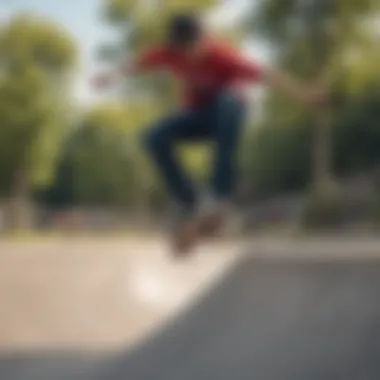

Regular Inspection and Cleaning
Cleaning your skateboard and keeping an eye on its various components can save you from unexpected mishaps later on. Regular inspections should involve checking for dirt and debris that might accumulate on the wheels and deck. A dirty board can lead to poor performance and, in some cases, can even result in accidents.
To clean your cruiser skateboard:
- Wipe down the deck with a damp cloth to remove dust.
- Use a soft brush to clean the wheels and make sure there's no grip tape residue stuck on them.
- Check the grip tape for wear and tear.
By making it a habit to clean and check your board, you maintain its aesthetics and improve its function.
Troubleshooting Common Issues
Loose Trucks
Loose trucks can be a major contributor to a bad riding experience. Over time, the nuts and bolts on your trucks may loosen, which can affect your control and stability while riding. A common sign that your trucks are loose is excessive wobbling when turning; this can turn a fun ride into a scary one pretty quickly.
- Key Characteristic: The pivot points of your trucks allow for turns and adjustments in your ride.
- Why it's Beneficial: Addressing loose trucks improves stability, giving you more confidence when making turns or riding downhill.
- Advantages: Tightening the trucks before a ride can significantly enhance your control. However, tightening them too much might make your rides less maneuverable. Finding that sweet spot is essential.
Worn Wheels
Worn wheels can significantly affect how your skateboard rolls. If you notice your wheels are getting flat spots or showing signs of wear, it’s time to consider a change.
- Key Characteristic: The hardness and composition of the wheel dictate how well it grips the surface.
- Why it's Beneficial: Having fresh wheels can drastically improve grip and the overall feel of your ride.
- Unique Feature: Softer wheels tend to grip better but wear out quicker, while harder wheels last longer but might slip during sharp turns. Balance is key.
When to Seek Professional Help
It's good to be handy and check your board regularly, but sometimes, expert eyes are needed. If you're noticing persistent issues such as unusual sounds or instability despite your maintenance efforts, it’s prudent to consult a professional.
Here are some signs that might warrant a visit to the skate shop:
- Frequent loose trucks despite regular tightening.
- Severe wheel wear that you can't seem to correct.
- Issues with your skateboard's bearings that you can't diagnose or fix on your own.
Fostering a relationship with a local skateboard technician can also give you peace of mind. They'll help you keep your board in top shape and can offer tailored advice based on your riding style.
"A little care goes a long way. Treat your board well, and it will treat you better."
By regularly inspecting and maintaining your cruiser, you ensure that you’re always ready to roll safely and smoothly. Remember, your board is an investment, and taking time to care for it can pay off in spades.
Building Community and Embracing Skate Culture
Skateboarding extends beyond just riding a board; it encapsulates a vibrant culture and a sense of belonging that can be particularly important for beginners. For those new to cruiser skateboards, understanding how to build community and embrace this culture provides not just motivation but also access to essential resources, camaraderie, and learning opportunities. The skateboard scene thrives on shared stoke and passion, making it crucial for novices to engage with others who share their interests.
Connecting with Local Riders
Getting involved with local riders can significantly enhance your skatin' experience. This begins with simply hitting the parks or popular spots within your city. Many areas have vibrant skate spots where you can meet fellow enthusiasts. Whether you’re at the local skatepark or cruising designated paths, talking to others can open up doors to valuable knowledge and friendships. Additionally, consider joining local skate clubs or groups, where you can find a sense of belonging while immersing yourself further in the sport.
Don’t underestimate the power of social media; platforms like Facebook or Reddit are treasure troves for local skateboarding communities. Connecting with riders from your region or city can lead to organized meet-ups, where you can learn, share ideas, and elevate your skills.
"Skateboarding is a community that welcomes everyone, no matter the skill level."
Participating in Events and Competitions
Being part of events, whether it’s a casual group ride or a more formal competition, fosters a spirit of camaraderie. Many cities host skateboarding events that range from friendly contests to full-blown competitions. Participating in these activities can be an excellent way for beginners to feel the pulse of the skate community. They often showcase a wide array of styles, from the laid-back cruising typical of beginners to the technical skills exhibited by seasoned skaters.
Local events also provide a platform to learn from one another. Watching experienced skaters perform, and perhaps even trying out a few tricks yourself, can inspire newcomers and instill confidence. Don’t shy away from competitions either; they’re not just about winning but about pushing yourself and connecting with others who are equally passionate about skateboarding.
Engaging with Online Forums and Resources
In this digital age, online forums and communities have become indispensable resources for aspiring skateboarders. Websites like Reddit offer dedicated sections for skateboarders, where you can ask questions, share your journey, or simply observe conversations. This kind of engagement helps build a virtual support network, which can be especially beneficial for beginners who might feel daunted by the in-person atmosphere.
YouTube channels and tutorials cover everything from the basics of cruiser skateboards to tips on navigating tricky tricks. Many influencers also share their experiences, which can be both educational and motivating. Additionally, books and articles addressing various aspects of skateboarding—from history to technique—can provide a broader context for your journey.
In summary, building community and embracing skate culture isn't merely about learning to ride; it’s about immersing oneself in a lifestyle that fosters growth, friendship, and enjoyment. Skaters, whether seasoned or beginner, thrive on this intertwined experience, constantly feeding off each other's energy and enthusiasm. As you embark on your cruiser skating journey, keep in mind that the connections you make and the culture you immerse yourself in will greatly enrich your experience on wheels.
Resources for Aspiring Skateboarders
For those stepping into the world of cruiser skateboards, having access to the right resources can make a world of difference. These resources serve as a goldmine of knowledge, providing guidance, tips, and support for new riders. Whether you are looking to sharpen your skills, connect with fellow skaters, or simply gather information, these tools will help you navigate your newfound passion more effectively.
Recommended Skateboarding Websites
The internet is chock-full of content related to skateboarding, and there are several key websites that stand out. Here are a few that every beginner should have bookmarked:
- Wikipedia – Offers a comprehensive overview of various skateboarding styles, techniques, and the history of skateboarding. This is a great starting point for understanding the context of your new hobby.
- Britannica – Similar to Wikipedia, but with more curated and reliable articles about skateboarding trends, gear, and safety tips.
- Reddit – Be sure to browse through communities like r/skateboarding for discussions, advice, and experiences from seasoned skaters. Getting insights from others can help you avoid rookie mistakes.
- Facebook Groups – Look for local skater groups where you can ask questions, share tips, and even find skate buddies. These communities can be invaluable to your progress.
Books and Tutorials
Though the digital age has normalized video tutorials, don’t underestimate the impact of a good book or a comprehensive guide. Here’s a selection of both that offer solid insights into the skating world:
- "Skateboarding: Book of Tricks” by Mark Daniel – This book breaks down tricks step by step, making it easier for beginners to learn at their own pace.
- "The Skateboarding Field Manual” by Mike O’Meally – A well-rounded guide that covers everything from the basics to advanced techniques. It's filled with illustrations that can clarify complex maneuvers.
- Online Tutorials – Websites like Skateboarding.com offer free tutorials that range from basic movements to trick execution. They also often have sections dedicated to safety, which is crucial for beginners.
YouTube Channels and Influencers
Youtubers have revolutionized the way we learn. Visually watching someone execute skateboard tricks can clarify things in ways that text cannot. Here are some channels and influencers worth following:
- Braille Skateboarding – This channel is perfect for beginners. They break down tricks and provide tutorials that are not only informative but also entertaining.
- The Berrics – A more established brand, focusing on professional skateboarders. They have a wealth of how-tos and skate culture content.
- Kurtis Skateboarding – He specializes in an easy-going teaching style, ensuring that every aspect of the sport is accessible to newcomers.
Having resources at your fingertips is paramount for learning and growth in any new endeavor. When it comes to skating, these websites, books, and channels provide both foundational knowledge and community support to guide your journey.

